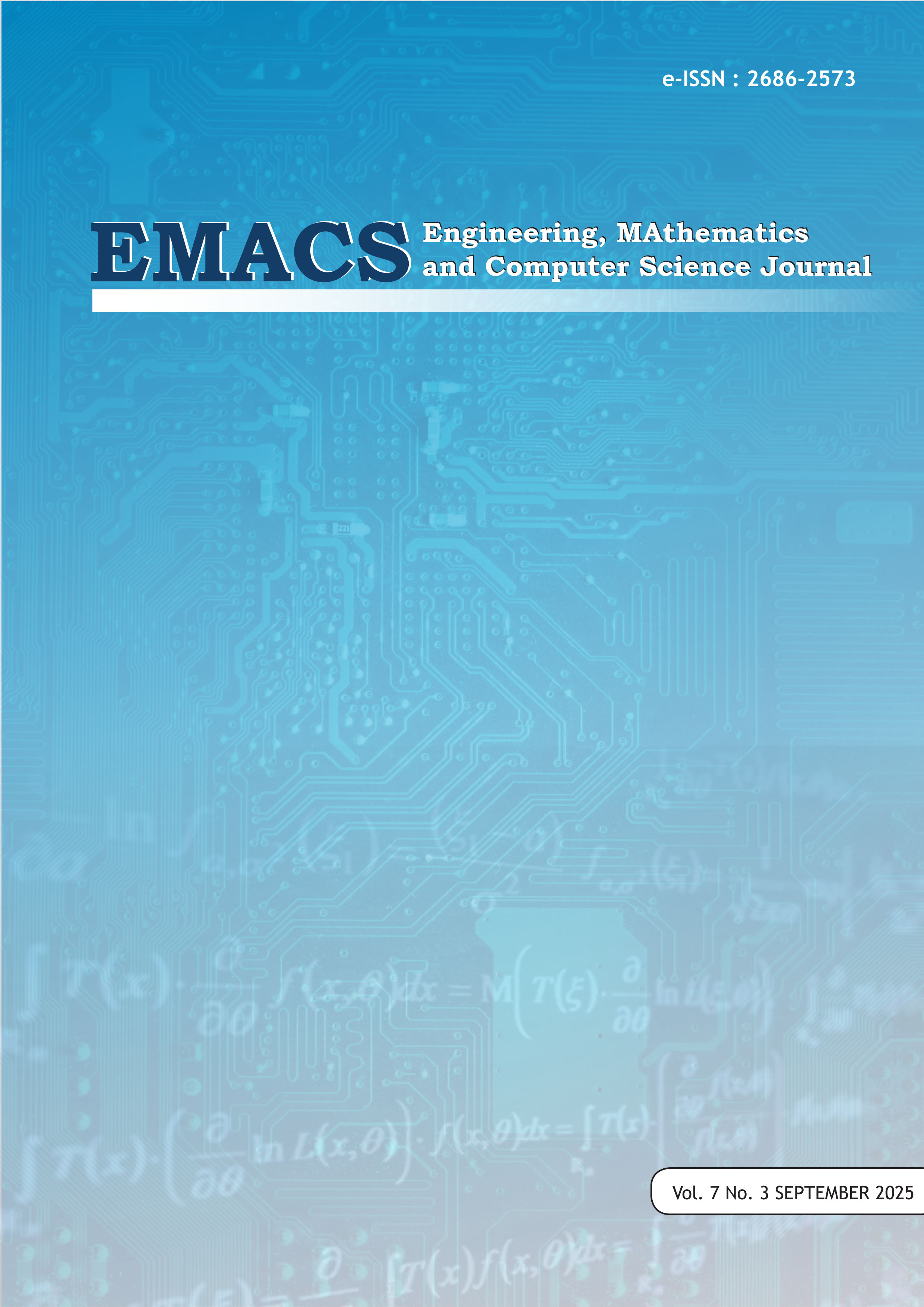Rice Hull Management System: A Mobile-based Application Tool for Cooperatives
DOI:
https://doi.org/10.21512/emacsjournal.v7i3.13839Keywords:
cooperatives, data analytics, mobile-based application, real-time, user-friendlyAbstract
This study focuses on the design and thorough assessment of the Rice Hull Management System RHMS for mobile devices, which targets cooperatives located specifically in Occidental Mindoro, Philippines. The Philippines is well-known for its rice production; however, there are severe concerns regarding environmental sustainability due to the poor management of rice hulls. To offer a solution, the Rice Hull Management System mobile application was created for user cooperatives from Occidental Mindoro. The application was developed using the RAD methodology with React Native and Firebase, enabling the system to be responsive, scalable, and secure. Through the utilization of RHMS, rice hull transactions are processed more efficiently with automated summaries, precision reports, advanced analytics, and real-time updates, all of which facilitate information-based decision-making and foster eco-friendly agricultural practices within and outside the region. The implementation evaluation of the system was conducted using a combination of surveys, usability tests, and performance benchmarks, which included IT specialists, cooperative staff, and members. System reliability was demonstrated to be high, with a Cronbach’s alpha greater than 0.80 and high user satisfaction, with grand mean scores ranging from 4.08 to 4.23 (“Very Good”). Evaluated criteria for the RHMS included efficiency, integration, usability, reliability, safety, and mobility, all of which received excellent ratings, confirming the system's effectiveness in resolving operational manual inefficiencies and enhancing transparency. This study focuses on the application of technology in rice hull waste management to promote environmental sustainability while meeting the requirements of agricultural cooperatives. The RHMS showcases considerable promise for development and implementation across agricultural supply chains, given its secure, easy-to-use, and flexible interface for users, administrators, and cooperatives. Proposed recommendations included continuous system enhancements, compliance with health regulations, integration with other platforms, and training programs to foster sustained system utilization and impact.
References
Bandumula, N. (2018). Rice Production in Asia: Key to Global Food Security. Proceedings of the National Academy of Sciences India Section B - Biological Sciences, 88(4), 1323–1328. https://doi.org/10.1007/s40011-017-0867-7
Chandran, V. P., Balakrishnan, A., Rashid, M., Kulyadi, G. P., Khan, S., Devi, E. S., Nair, S., & Thunga, G. (2022). Mobile applications in medical education: A systematic review and meta-analysis. PLoS ONE, 17(3 March), 1–22. https://doi.org/10.1371/journal.pone.0265927
Dhal, S., Wyatt, B. M., Mahanta, S., Bhattarai, N., Sharma, S., Rout, T., Saud, P., & Acharya, B. S. (2024). Internet of Things (IoT) in digital agriculture: An overview. Agronomy Journal, 116(3), 1144–1163. https://doi.org/10.1002/agj2.21385
Farooq, M. S., Riaz, S., Rehman, I. U., Khan, M. A., & Hassan, B. (2023). A Blockchain-Based Framework to Make the Rice Crop Supply Chain Transparent and Reliable in Agriculture. Systems, 11(9), 1–17. https://doi.org/10.3390/systems11090476
Ghodake, M. R. (2024). Smart Agriculture Management System: Integration of IoT Technology and Mobile Application for Enhanced Farming Practices. International Journal for Research in Applied Science and Engineering Technology, 12(4), 1813–1818. https://doi.org/10.22214/ijraset.2024.59823
Goodman, B. A. (2020). Utilization of waste straw and husks from rice production: A review. Journal of Bioresources and Bioproducts, 5(3), 143–162. https://doi.org/10.1016/j.jobab.2020.07.001
Gowlla, J., Abdul Salam, B., & Sahu, P. K. (2025). Cleaner energy production by combined use of biomass plants and thermal plants: a novel approach for a sustainable environment. Sustainable Environment Research, 35(1). https://doi.org/10.1186/s42834-025-00248-y
Herpiah, H., Zulkarnaen, M.R., Prasetyo, J. & Haryono, W.. (2024). Sistem Informasi Pembayaran SPP dan Tabungan Siswa Berbasis Web di SMP Putra Bangsa. Mars : Jurnal Teknik Mesin, Industri, Elektro Dan Ilmu Komputer, 2(6), 201–210. https://doi.org/10.61132/mars.v2i6.554
Huang, Y. F., & Lo, S. L. (2018). Utilization of rice hull and straw. In Rice: Chemistry and Technology. AACCI. Published by Elsevier Inc. in cooperation with AACC International. https://doi.org/10.1016/B978-0-12-811508-4.00019-8
Jandrić, P., Hayes, D., Truelove, I., Levinson, P., Mayo, P., Ryberg, T., Monzó, L. D., Allen, Q., Stewart, P. A., Carr, P. R., Jackson, L., Bridges, S., Escaño, C., Grauslund, D., Mañero, J., Lukoko, H. O., Bryant, P., Fuentes-Martinez, A., Gibbons, A., … Hayes, S. (2020). Teaching in the Age of Covid-19. Postdigital Science and Education, 2(3), 1069–1230. https://doi.org/10.1007/s42438-020-00169-6
Kemhe, J. M., Luhanga, E. T., & Kisangiri, M. (2022). Mobile Application for Research Knowledge Sharing and Dissemination: The Case of Nm-Aist University, Tanzania. Journal of Software Engineering and Applications, 15(07), 209–219. https://doi.org/10.4236/jsea.2022.157012
Kumarathilaka, P., Bundschuh, J., Seneweera, S., & Ok, Y. S. (2021). An integrated approach of rice hull biochar-alternative water management as a promising tool to decrease inorganic arsenic levels and to sustain essential element contents in rice. Journal of Hazardous Materials, 405(September), 124188. https://doi.org/10.1016/j.jhazmat.2020.124188
Mamiit, R. J., Yanagida, J., & Villanueva, D. (2020). Farm locations and dwelling clusters: Do they make production and technical efficiency spatially contagious? Food Policy, 92(March 2019), 101883. https://doi.org/10.1016/j.foodpol.2020.101883
Mohidem, N. A., Hashim, N., Shamsudin, R., & Man, H. C. (2022). Rice for Food Security: Revisiting Its Production, Diversity, Rice Milling Process and Nutrient Content. Agriculture (Switzerland), 12(6). https://doi.org/10.3390/agriculture12060741
Nengah Riki, & Tata Sutabri. (2024). Perancangan Aplikasi Pendeteksi Hama Tanaman Padi Berbasis Android. Uranus : Jurnal Ilmiah Teknik Elektro, Sains Dan Informatika, 2(4), 215–222. https://doi.org/10.61132/uranus.v2i4.510
Peng, X., Zhang, X., Wang, X., Li, H., Xu, J., & Zhao, Z. (2022). Construction of rice supply chain supervision model driven by blockchain smart contract. Scientific Reports, 12(1), 1–22. https://doi.org/10.1038/s41598-022-25559-7
Prochazka, R., Valicek, J., Harnicarova, M., Kusnerova, M., Tozan, H., Borzan, C., Kadnar, M., Palkova, Z., Galik, R., & Slamova, K. (2024). Collection of Plastic Packaging of Various Types: Sorting of Fractions of Plastic Waste Using Both Automated and Manual Modes. IEEE Access, 12(March), 44244–44261. https://doi.org/10.1109/ACCESS.2024.3376230
Quispe, I., Navia, R., & Kahhat, R. (2017). Energy potential from rice husk through direct combustion and fast pyrolysis: A review. Waste Management, 59, 200–210. https://doi.org/10.1016/j.wasman.2016.10.001
Tyagi, S., Reddy, S. R. N., Anand, R., & Sabharwal, A. (2024). Enhancing rice crop health: a light weighted CNN-based disease detection system with mobile application integration. In Multimedia Tools and Applications (Vol. 83, Issue 16). Springer US. https://doi.org/10.1007/s11042-023-17449-5
Verma, V., Vishal, B., Kohli, A., & Kumar, P. P. (2021). Systems-based rice improvement approaches for sustainable food and nutritional security. Plant Cell Reports, 40(11), 2021–2036. https://doi.org/10.1007/s00299-021-02790-6
Xing, Y., Wang, J., Shaheen, S. M., Feng, X., Chen, Z., Zhang, H., & Rinklebe, J. (2020). Mitigation of mercury accumulation in rice using rice hull-derived biochar as soil amendment: A field investigation. Journal of Hazardous Materials, 388(November). https://doi.org/10.1016/j.jhazmat.2019.121747
Downloads
Published
How to Cite
Issue
Section
License
Copyright (c) 2025 Maricris Usita, Cris Ann Fogusa Timalog, Maychiel Javier, Jhune Carlo Indap, Gricelyn Calera, Jessa Jane Ramos

This work is licensed under a Creative Commons Attribution-ShareAlike 4.0 International License.
Authors who publish with this journal agree to the following terms:
- Authors retain copyright and grant the journal right of first publication with the work simultaneously licensed under a Creative Commons Attribution License - Share Alike that allows others to share the work with an acknowledgment of the work's authorship and initial publication in this journal.
- Authors are able to enter into separate, additional contractual arrangements for the non-exclusive distribution of the journal's published version of the work (e.g., post it to an institutional repository or publish it in a book), with an acknowledgment of its initial publication in this journal.
- Authors are permitted and encouraged to post their work online (e.g., in institutional repositories or on their website) prior to and during the submission process, as it can lead to productive exchanges, as well as earlier and greater citation of published work.
USER RIGHTS
All articles published Open Access will be immediately and permanently free for everyone to read and download. We are continuously working with our author communities to select the best choice of license options, currently being defined for this journal as follows: Creative Commons Attribution-Share Alike (CC BY-SA)





